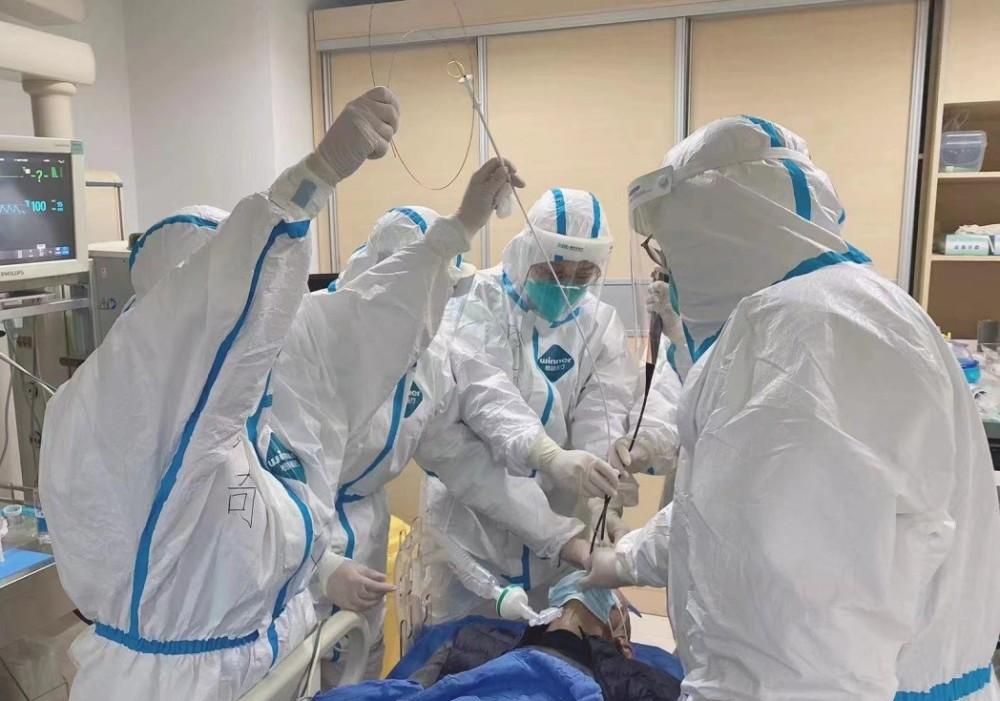On April 25, the surging news (www.thepaper.cn) reporter learned from Shanghai Changhai Hospital that since the beginning of April, Changhai Hospital has successfully completed more than 50 cases of emergency respiratory endoscopy treatment.
Respiratory endoscopic interventional diagnosis and treatment services are provided for patients with respiratory failure caused by critical airway stenosis and lung diseases, and the life is at stake. Since the beginning of April, Changhai Hospital has set up a respiratory endoscopic rapid treatment team, set up a "buffer bronchoscopy room", and is on duty 24 hours a day to treat patients with related diseases.
According to Changhai Hospital, 86-year-old Meng Laobo, who lives in Pudong, was diagnosed with esophageal cancer for 6 months, and has been treated with radiotherapy and chemotherapy for 6 months without surgery. During the epidemic period, suddenly appeared shortness of breath, breathing difficulties, can not lie flat and other symptoms for 10 days, lung CT suggests that the external pressure of the esophageal tumor caused severe narrowing of the upper trachea, the narrowest part of the trachea diameter is only 2-3mm, there is a risk of tracheal suffocation death at any time, and many hospitals were admitted to the emergency department of Changhai Hospital on April 21.
After the evaluation of the respiratory endoscopy team of the hospital, Meng Laobo has indications for emergency bronchoscopic tracheal stent placement, that is, a stent is placed in the narrowest trachea through bronchoscopy to expand the stenosis, so as to achieve the treatment purpose of smooth breathing. The treatment team took only 10 minutes to successfully complete the tracheal laminated stent insertion under intravenous induction anesthesia, and after the operation, Meng Laobo was able to walk on the ground on his own, the breathing difficulty was completely alleviated, and the next day he was discharged from the emergency room and discharged home.

Emergency transbronchoscopic tracheal severe tumor stenosis transbronchage stenting The pictures in this article are provided by Shanghai Changhai Hospital
Unlike Lao bo Meng, the patient Aunt Zhu needs to receive regular respiratory endoscopy treatment to live a safe life. Aunt Zhu, a 62-year-old who lives in Chongming, recently relapsed after surgery of right lower lung cancer, and due to the impact of the epidemic, the endoscopic center of the hospital she had been treating was closed, and she did not undergo bronchoscopic ablation for 2 months, and gradually aggravated progressive dyspnea.
On April 22, Aunt Zhu learned that the bronchoscopy of Changhai Hospital did not stop and came to the emergency department of Changhai Hospital for treatment. After multidisciplinary consultation, it was determined that she had indications for emergency bronchoscopy treatment, and the respiratory endoscopy team timely successfully implemented the right main bronchial stent under intravenous induction anesthesia for Aunt Zhu and the high-frequency electrocoagulation ablation and cleansing of granulation tissue, which not only cleared the airway, but also cleaned up some tumors, and after the operation, Aunt Zhu's breathing difficulties were significantly alleviated, and she could walk normally, and was discharged from the emergency department the next day.
Closely monitor the patient for anesthesia to wake up.
"In the past 20 days, our team has implemented timely and effective electronic bronchoscopic intervention for emergency patients with severe scar stenosis after tracheal intubation in a car accident, cerebral infarction, severe pneumonia, poor position of tracheostomy cannula with tracheal obstruction, airway foreign bodies, etc., solving the problem of the great airway and saving the patient's life in time, the vast majority of patients can be relieved of emergency observation the next day, and after the solution of the airway problems of some patients, it also provides the possibility for the next step of treatment of underlying diseases." In addition, it is also important to do a good job in postoperative epidemic prevention and monitoring of patients, and within 1 week after surgery, we will follow up patients by phone to carry out health testing and report in a timely manner. Huang Haidong, deputy director of the Department of Respiratory Medicine of Changhai Hospital, said.
Professor Dong Yuchao, director of the Department of Respiratory Medicine of Changhai Hospital, said that the current two types of key treatment groups must be paid attention to, one is lung cancer patients who need continuous chemotherapy, targeted and PD-1 and other cyclical system therapy; the other is to pay special attention to emergency treatment of emergency and critically ill patients, strictly grasp the indications of emergency bronchoscopy, and strictly implement the preoperative assessment, flow adjustment, reporting and intraoperative three-level protection.